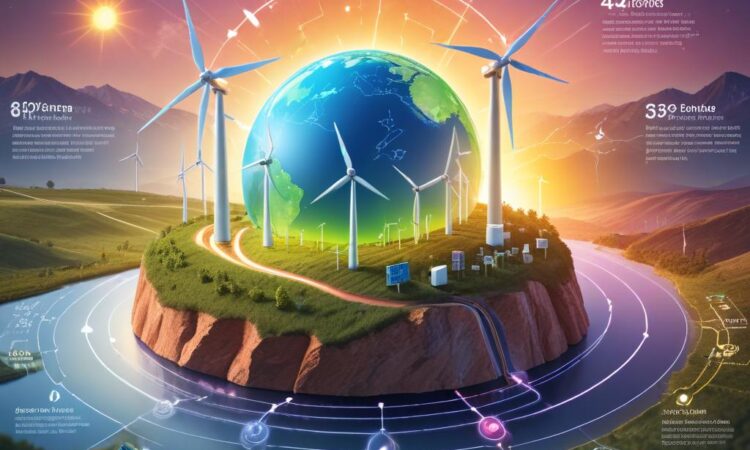Energy and Environmental Sustainability: The Transition to a Cleaner Future
The transition to cleaner energy sources is essential for addressing climate change and ensuring a sustainable future. Advancements in renewable energy and energy storage technologies are playing a key role in this critical shift.
The Urgent Need for Change
The world faces a pressing challenge: the need to reduce greenhouse gas emissions drastically to mitigate the worst impacts of climate change. Fossil fuels, while historically important, are a primary contributor to these emissions. Their continued use threatens the planet’s delicate balance and poses serious risks to ecosystems and human health.
The scientific consensus is clear: human activity is driving climate change, and immediate action is needed. Global temperatures are rising, sea levels are escalating, and extreme weather events are becoming more frequent and intense. These impacts are already being felt worldwide, from heatwaves and droughts to floods and storms.
The Rise of Renewable Energy
Renewable energy sources, such as solar, wind, hydro, and geothermal, offer a promising solution to this challenge. They are naturally replenishing, emitting far fewer greenhouse gases compared to fossil fuels. Moreover, their use contributes to energy independence and reduces reliance on volatile global energy markets.
Solar Power
Solar power harnesses the energy from the sun to generate electricity. Photovoltaic cells convert sunlight directly into electricity, while concentrated solar power uses mirrors to focus sunlight and generate heat, which drives turbines to produce electricity. Solar energy is becoming increasingly affordable and accessible, thanks to technological advancements and economies of scale.
Wind Power
Wind power utilizes wind turbines to capture the kinetic energy of wind and convert it into electricity. Wind energy is a reliable and sustainable source, especially in areas with consistent wind patterns. Wind farms can generate significant amounts of clean energy, contributing to a greener energy mix.
Hydropower
Hydropower relies on the power of flowing water to generate electricity. Hydroelectric dams capture the energy of falling water, driving turbines to produce electricity. While hydropower is a mature technology, it plays a significant role in many countries’ energy portfolios.
Geothermal Energy
Geothermal energy taps into the heat of the Earth’s interior to generate electricity. Geothermal power plants utilize steam or hot water from underground sources to drive turbines and produce electricity. Geothermal energy is a reliable and sustainable source, especially in areas with geothermal activity.
Energy Storage Technologies
Renewable energy sources are intermittent; they depend on natural factors like sunlight and wind availability. Energy storage technologies play a crucial role in bridging the gap between supply and demand, ensuring a consistent and reliable flow of clean energy.
Battery Storage
Batteries are a widely used energy storage solution, storing energy chemically and releasing it as electricity when needed. Lithium-ion batteries are a dominant technology in this sector, but advancements in other battery chemistries are continuously improving performance and reducing costs.
Pumped Hydro Storage
Pumped hydro storage is a mature and reliable energy storage system. It involves pumping water uphill to a reservoir during periods of low demand and releasing it through turbines to generate electricity when demand is high.
Hydrogen Storage
Hydrogen is a versatile energy carrier that can be produced from renewable sources and stored for later use. Hydrogen can be used directly as a fuel or converted back into electricity using fuel cells. While still in its early stages, hydrogen storage holds significant potential as a long-duration energy storage solution.
The Future of Clean Energy
The transition to a clean energy future is well underway, driven by technological advancements, policy initiatives, and growing public awareness. The cost of renewable energy technologies has plummeted, making them increasingly competitive with fossil fuels. Governments worldwide are setting ambitious targets for renewable energy deployment and carbon emission reductions. Businesses and individuals are increasingly embracing sustainable energy practices, driving innovation and market growth.
The path to a sustainable energy future is not without challenges. Investment, infrastructure development, and grid modernization are crucial aspects of this transition. Addressing concerns about land use, wildlife impacts, and community engagement is essential for ensuring a just and equitable energy transition.
Despite these challenges, the transition to a clean energy future is both necessary and achievable. By embracing renewable energy and energy storage technologies, investing in sustainable infrastructure, and fostering international collaboration, we can build a brighter and more sustainable future for generations to come.
Conclusion
The shift towards cleaner energy sources is an imperative for addressing climate change and building a sustainable future. Renewable energy and energy storage technologies offer a promising path toward achieving this goal. By embracing these innovations, fostering collaboration, and committing to a collective vision, we can create a world powered by clean and sustainable energy, ensuring a healthier planet and a brighter future for all.

